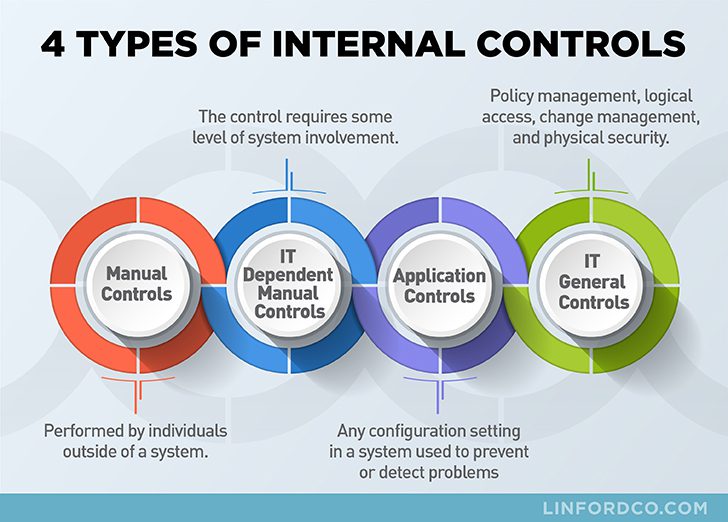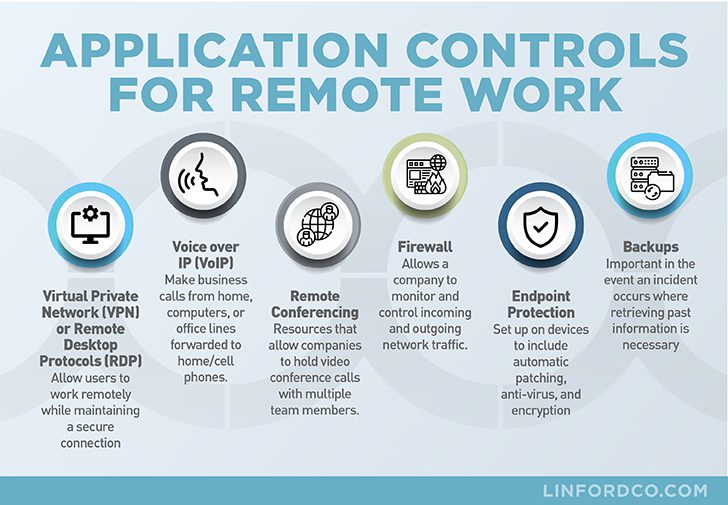Which Of The Following Is Considered An Application Input Control?
Internal controls (which include manual, Information technology-dependent manual, Information technology general, and awarding controls) are essential process steps that allow for one to determine or confirm whether sure requirements are existence washed per a sure expectation, law, or policy. Additionally, internal controls allow auditors to perform tests to gain assurance that a procedure is designed and operating properly.
In this mail, we will discuss the definition of controls and examples of the different types of internal controls used to support business processes. Finally, nosotros will besides discuss how auditors rely on internal controls and how understanding that can help a company prepare for an upcoming SOC 1, SOC 2, HIPAA, or another type of audit.
What are Internal Controls?
According to the Executive Summary of the Internal Control – Integrated Framework from the Committee of Sponsoring Organizations (COSO), an "internal control is a procedure, effected past an entity'due south board of directors, management, or other personnel, designed to provide reasonable balls regarding the achievement of objectives relating to operations, reporting, and compliance." The main goal of having internal controls is to set up up central points in a process, which allows companies to rail progress and sustainability of performance. In the side by side section, we will review control definitions and internal control examples.

What Are the 4 Dissimilar Types of Controls?
When performing an audit, auditors will look to come across that they tin gain assurance over a procedure past focusing on four main types of internal controls. These types of controls consist of the following:
- Manual Controls
- IT Dependent Transmission Controls
- Application Controls
- Information technology General Controls
The iv types of internal controls mentioned in a higher place are key as they are pervasive (or at least should be) in the processes that support the systems and services provided past service organizations to their user organizations (i.e. clients and customers).

What Are Internal Control Definitions & Examples?
What Are Transmission Controls?
Manual controls are performed by individuals outside of a system.
What Are Some Examples of Manual Controls?
Examples of manual controls could be a supervisor review and sign-off of a certificate, bank reconciliation, or having an employee sign a privacy policy acknowledgment. Another instance of a manual control could exist the transmission application (or matching) of greenbacks received in an organisation'south lockbox bank business relationship confronting a client'southward open up accounts receivable (A/R) balance. In many organizations, these controls are washed manually, hence the term manual controls.
Since the operation of these controls depends on a human, it is primal that these process points have owners. When transmission controls are not owned by central personnel within the system, they often volition non operate consistently. This generally poses an issue considering to properly test manual controls, a sample of transactions is chosen to ostend that the control has operated for a divers period of time. If the control did not operate consistently, a departure or exception volition exist noted inside the audit study.

What Are IT-Dependent Transmission Controls?
Information technology Dependent Manual Controls are similar to manual controls as they rely on a manual process from personnel merely differ as a portion of the control requires some level of system involvement.
What Are Some Examples of It-Dependent Transmission Controls?
A system-generated written report lists users that have not accessed (due east.g., logged into a system) a detail organization within the past xc days. The internal control may crave an administrator to review such reports and disable certain users whose accounts take non been accessed within the defined 90 days, as a consequence.
The IT-dependent portion of this control is the organization-generated report. The manual portion of this control is the administrator review of the report and disabling sure users as a result.
Much like manual controls, IT-dependent manual controls should accept a process owner. This will facilitate the consistent operation of these controls and avoid any exceptions being noted inside an audit written report.

What Are Application Controls?
At that place are many dissimilar forms of application controls. Virtually any configuration setting in a system that can be used to prevent or detect problems might exist classified as a type of awarding control.
What Are Some Examples of Application Controls?
Google G-Suite and Microsoft's Office 365 can be configured to crave two-cistron authentication (e.g., 2FA, MFA) in order for users to log in and access organisation resources and data. Enabling 2FA helps forbid unauthorized users from logging in to the system.
Another example is if the system is configured to lock out a user that enters an incorrect countersign afterwards three attempts, it has an application command that detects issues possibly associated with unauthorized access attempts.
A third instance could be that the organization is configured to automatically download and apply security patches or updates to software (this would have probable helped prevent the Equifax hack).
Application controls which are also known every bit automated controls have a few benefits. 1 do good is that because the command is the result of a configuration, they generally do rely on an individual to operate consistently. That being said, it is always a good idea to periodically check to confirm that the configuration has not been disabled for whatever reason or the configuration has non been modified.
In the event that a configuration has been modified or is no longer enabled, this can consequence in an exception inside the report. Another benefit of having application or automated controls is that in that location is generally merely a sample of one versus many since it is based upon a system configuration. This creates efficiency in the process and saves time during an audit.

What Are Information technology General Controls?
This blazon of control is usually the focal point of most SOC audits. Information technology general controls are comprised of policy direction, logical access, change management, and concrete security.
What Are Some Examples of IT General Controls?
User access administration controls are used so that the correct people have the right admission to system resources (i.e., right people & correct access). These processes and the controls supporting these processes are IT general controls.
Another example could be the arrangement'due south change direction procedure tracks and documents that changes are authorized, tested, approved, and implemented into product. Moreover, it helps an arrangement proceeds assurance that changes happen in an environment where there is proper segregation of duties.
IT General Controls can be a combination of manual and application controls. Equally such, the type of sampling to test these controls varies by control type.

Preventative & Detective Controls
In addition to the types of controls named, internal controls are either preventative or detective in nature (note: sometimes cosmetic is added; nonetheless, information technology really should be considered function of detective, as in detective and cosmetic).
All other things existence equal, preventative controls are more often than not superior to detective controls. The reason is this- it is unremarkably easier and more cost-constructive to right a situation before a problem occurs than to correct a problem after detection. Those implementing internal controls into their environment will be well served by implementing a combination of preventative and detective controls with a greater focus on the former.
What Is the Purpose of Internal Controls?
The purpose of internal controls is to create touchpoints inside a procedure that can be evidenced and reviewed and ultimately create accountability while likewise lowering the risk of fraud, waste product, abuse, and simple mistakes.
Internal controls are generally fix upwards by management or the Board of Directors. They fix up internal controls to gain assurance that the objectives of an organization tin can exist achieved. This can be to run into internal milestones or even external requirements such every bit an inspect or industry standards.
Finally, internal controls allow for a company to class metrics around the efficiency and effectiveness of a process. During the review of internal controls, information technology tin can get obvious that a process is working every bit expected or at times the operating effectiveness of controls can bear witness to have failures. This allows management to determine if a different procedure is required to better meet company objectives.

What are Command Weaknesses?
A control weakness can fall into one of two categories. In that location is either a weakness in the blueprint of a control or in its operating effectiveness. When there is a control weakness in the design of a command, that means that information technology was non in place, and as a consequence, a control failure occurred. For case, if there is a requirement for monthly patching simply there is no control in identify to validate that information technology occurs, the take chances that patching does not occur and that a vulnerability can exist exploited is increased. This is considered a control weakness specific to the design of a command.
The other blazon of command weakness is a deficiency in the operating effectiveness of a command. In this scenario, a process exists but due to a arrangement error or personnel failure, the control does not operate as expected. Let's go back to the server example. Let'due south say that the organisation has a process in which the system administrator is supposed to manually utilise patches each month. Withal, due to turnover, patching does not occur for a number of months. The months that the server was non patched is considered a control weakness, specific to the operating effectiveness.
How Practise You Strengthen Internal Controls?
The best way to strengthen internal controls is by completing a review of the current controls in place and performing a limited amount of testing to determine whether required controls operated as expected. If during the review it is determined that controls are not ever operating consistently, then remediation steps should be documented and implemented. Additional testing for controls that are deficient should be re-evaluated inside a few months to determine whether required implementation steps occurred.
A more than formalized arroyo to strengthening internal controls tin also be done by having a 3rd political party come up in to perform a review of controls and provide input on whether a process could be updated to strengthen controls. This can be in the form of a SOC 1 or SOC ii written report, another security framework, or by having the 3rd party complete advisory piece of work. This can exist a great option as the tertiary political party tin can provide their professional opinion and recommendations based on the manufacture standard. One affair to note is that strengthening of controls should not necessarily mean more coin or a more complex process that does non align with Company requirements. When strengthening controls, the best choice is generally 1 that streamlines the process and makes it easier to complete a control consistently, not harder.

Internal Controls & Coronavirus (COVID-19)
During these times, it may seem like working and implementing controls is either impossible or irrelevant, but in fact, in high-stress times like these internal controls are even more than important. The reason for this is that stressful times can create urgency which often leads to mistakes. But with controls in place, as mentioned earlier, controls tin can aid lower the risk that they occur or will exist caught during a review. There is some other major departure many companies are having to work out, which is having much of their workforce work from domicile. There are a number of application controls that tin aid a company do this while protecting client information. Below are a few application command examples that companies should consider as they continue to shore up their work from home processes.

- Virtual Private Network ( VPN ) or Remote Desktop Protocols (RDP) – These allow users to work remotely while maintaining a secure connection to protect client data.
- Voice over IP (VoIP) – Using VoIP allows businesses to brand business organization calls from home, from their computers, or even have office lines forwarded to home or cell phones.
- Remote Conferencing – There are a number of resource that allow companies to hold video conference calls with multiple team members. Some examples include but are not limited to Google Hangouts, Microsoft Teams, Zoom, Skype for Business, and GoToMeeting.
- Firewall – A firewall allows a company to monitor and control incoming and outgoing network traffic based on predetermined security rules.
- Endpoint Protection – Setting up endpoint protection on devices such as laptops and mobile phones to include automatic patching, anti-virus, and encryption is helpful in protecting client data being accessed or maintained from outside the network.
- Backups – Having a process in identify to backup and consummate restores is important in the event an incident occurs where retrieving past information is necessary.
Finally, the best grade of action is to stay calm. The environment that your remote workforce is currently working in may not be perfect but that does not mean you should stress out and make decisions without proper testing and completing vendor due diligence. It's important to go on working with the internal controls possible today and make changes equally required to create a more secure surroundings and even meliorate system of internal control with the main objective of protecting client information.
Summary
If the controls in the SOC audit report do not seem to fall into one of these iv areas, it could be that a procedure is existence described rather than a control.
Linford & Company service auditors work advisedly with the service organizations to make sure that descriptions of the controls are accurate and support the achievement of the control objectives in a SOC 1 audit examination or Trust Services Criteria (TSC) for a SOC 2 inspect examination.
It'due south also important to note that these definitions and descriptions piece of work every bit well for an inspect of internal control in a fiscal statement audit, or for internal audits.
For more information, bank check out these other related Linford & Company posts:
- What is an Integrated Audit? Assessing Internal Controls
- Establishing an Constructive Internal Command Environment
- Agreement the Limitations of Internal Controls – Learning to Mitigate Your Take chances
- Monitoring the Effectiveness of Controls at Subservice Organizations for SOC Reports
This article was originally published on iii/31/2020 and was updated on 1/25/2022.

Jaclyn Finney started her career every bit an auditor in 2009. She started with Linford & Co., LLP. in 2016 and is a partner with the firm. She is a CISA with a special focus on SOC, HITRUST, FedRAMP and royalty examinations. Jaclyn works with her clients to provide a procedure that meets the needs of each client and generates a tailored study that is useful to the client and the users of the report.
Which Of The Following Is Considered An Application Input Control?,
Source: https://linfordco.com/blog/types-of-controls/
Posted by: reecemonexte.blogspot.com


0 Response to "Which Of The Following Is Considered An Application Input Control?"
Post a Comment